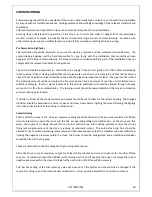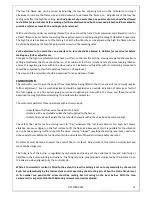
C07100DC023
61
The low fire flame size can be varied by adjusting the low fire adjusting screw on the carburator, turning it
clockwise to increase the flame size and anticlockwise to decrease the flame size. Adjustment of the low fire
setting will affect the high fire setting.
Each adjustment of no more than one quarter of a turn should be allowed
to stabilize for ten minutes before making a further adjustment and both screw and plate should be marked to
provide a reference to which the settings can be returned
.
With a satisfactory minimum setting achieved the stove should be turned to its maximum and allowed to run for
at least fifteen minutes before measuring the negative pressure and adjusting the draught stabilizer if necessary.
The high fire rate has been set at the factory but as the low fire rate can be adjusted, the high fire flame size can
be varied by adjusting the high fire adjustment screws on the metering valve.
Each adjustment of no more than one quarter of a turn should be allowed to stabilize for ten minutes before
making any further adjustments.
Changes to the high fire adjustment will have no effect on the low fire setting. Having completed the maximum
setting adjustments the stove should be run at its minimum for thirty minutes and a pressure reading taken to
ensure the negative pressure within the stove such as a Flexitemp unit together with its controlling components
should be subjected to their full operating functions. (If approved)
The stove and the oil system should be examined for any evidence of leaks.
CARBURATOR
The carburator is set to give the correct flow rates before being fitted to the stove and will not normally require
further adjustment. Even a small adjustment should be regarded as a possible indication of damage or fault of
the fuel supply, or of a flue system giving an incorrect negative pressure within the stove, and these should be
examined thoroughly before attempting to re-calibrate the carburator.
The carburator performs three operations within its main body:
- it regulates with a float valve the depth of oil held,
- it meters with an adjustable outlet the fuel supplied to the burner,
- It safety float valve will isolate the fuel should the levels within the valve body become too high.
The safety float will cause the arming lever to “trip” whenever the fuel levels become too high, but severe
vibration can cause ripples on the fuel surface to lift the float, and because of this it is possible for the vibration
set up by heavy passing traffic to shut off the valve. Having “tripped”, resetting the arming lever may need to be
done several times before the fuel level within the valve falls sufficiently to allow reliable operation.
No attempt must be made to adjust the control float or its level. Adjustment of this control is impractical and
may even be dangerous.
The firing rate of the burner is regulated by carburator and having set the extremes of low and high firing as
detailled in the commissioning instructions, the firing rates are proportioned as indicated by the indices 1-6 on
the valve top when aligned to by the control knob.
Where a thermostatic control is fitted to the valve, the low fire setting is set not only manually by the control
knob but automatically by the thermostatic control operating the actuating pin. When the control knob is set
to its number one position the screw should be resting, but not acting on the lever below. With the twin
carburator it is important that both balancing screws are correctly adjusted.
Содержание H11
Страница 1: ...MAZOUT OLIE OIL MODE D EMPLOI GEBRUIKSAANWIJZING INSTALLATION AND OPERATING INSTRUCTIONS ...
Страница 2: ...C07100DC023 1 ...
Страница 52: ...C07100DC023 51 FLUE CONNECTION IDEAL TO BE AVOIDED ...
Страница 53: ...C07100DC023 52 IDEAL TO BE AVOIDED ...
Страница 56: ...C07100DC023 55 ...
Страница 76: ...C07100DC023 75 ...
Страница 77: ...C07100DC023 76 SOTO DE LA MARINA CANTABRIA Apdo de correos 208 SANTANDER C07100DC023 04 2017 ...
















































